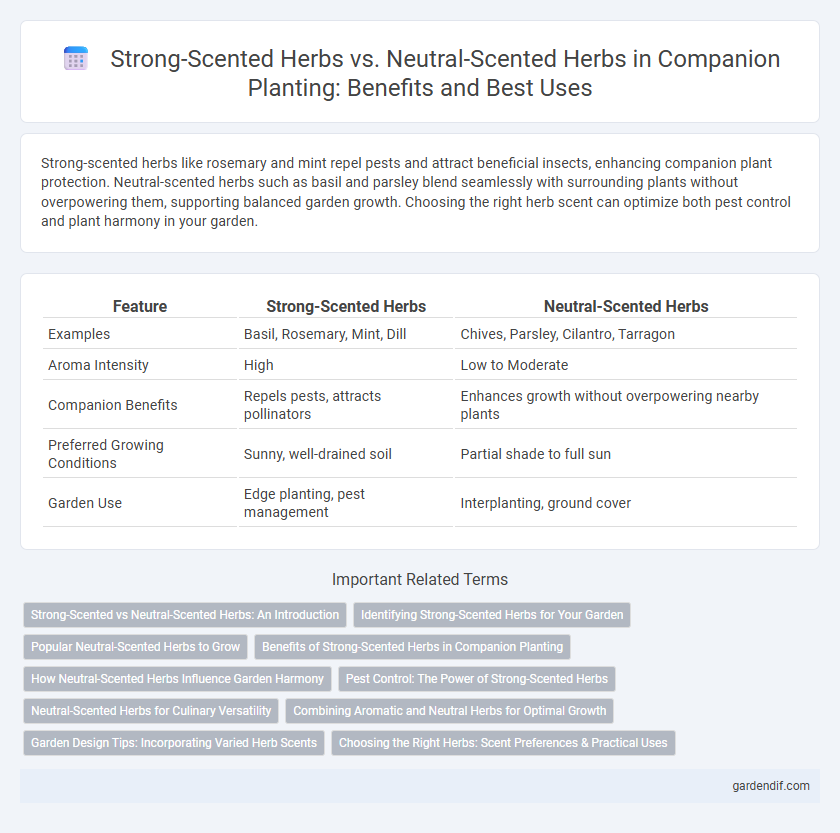
Strong-scented herbs vs neutral-scented herbs Illustration
Strong-scented herbs like rosemary and mint repel pests and attract beneficial insects, enhancing companion plant protection. Neutral-scented herbs such as basil and parsley blend seamlessly with surrounding plants without overpowering them, supporting balanced garden growth. Choosing the right herb scent can optimize both pest control and plant harmony in your garden.
Table of Comparison
| Feature | Strong-Scented Herbs | Neutral-Scented Herbs |
|---|---|---|
| Examples | Basil, Rosemary, Mint, Dill | Chives, Parsley, Cilantro, Tarragon |
| Aroma Intensity | High | Low to Moderate |
| Companion Benefits | Repels pests, attracts pollinators | Enhances growth without overpowering nearby plants |
| Preferred Growing Conditions | Sunny, well-drained soil | Partial shade to full sun |
| Garden Use | Edge planting, pest management | Interplanting, ground cover |
Strong-Scented vs Neutral-Scented Herbs: An Introduction
Strong-scented herbs like rosemary, thyme, and basil emit potent aromas that can repel pests and enhance the growth of neighboring plants in companion gardening. Neutral-scented herbs such as parsley, chervil, and chives have mild fragrances that do not strongly influence insect behavior but can coexist harmoniously with a wide range of plants. Understanding the differences in scent intensity helps gardeners strategically pair herbs to optimize pest control and promote healthy plant development.
Identifying Strong-Scented Herbs for Your Garden
Strong-scented herbs such as rosemary, thyme, and oregano release potent essential oils that can repel pests and attract beneficial insects, making them ideal companions for vegetable gardens. Identifying these herbs involves recognizing their robust aromatic profiles and leaves coated with fragrant oils, which intensify when crushed. Planting strong-scented herbs alongside neutral-scented varieties like basil or chervil helps create a balanced garden ecosystem that enhances growth and reduces the need for chemical treatments.
Popular Neutral-Scented Herbs to Grow
Popular neutral-scented herbs like chamomile, lemongrass, and marjoram offer subtle aromas that complement companion planting without overpowering neighboring plants. These herbs attract beneficial insects such as pollinators and predatory bugs, enhancing garden health and pest control naturally. Their mild fragrances make them ideal for mixed herb gardens where strong scents might interfere with other plants' growth or pollinator attraction.
Benefits of Strong-Scented Herbs in Companion Planting
Strong-scented herbs like rosemary, thyme, and basil enhance companion planting by naturally repelling pests such as aphids, cabbage moths, and whiteflies, reducing the need for chemical pesticides. These aromatic herbs attract beneficial insects like bees and predatory wasps, improving pollination and biological pest control. Their volatile oils also mask the scent of nearby crops, confusing pests and protecting vulnerable plants from infestations.
How Neutral-Scented Herbs Influence Garden Harmony
Neutral-scented herbs like basil and parsley create a balanced aroma that promotes garden harmony by not overpowering nearby plants, allowing pollinators to visit diverse flowers without confusion. Their subtle fragrance supports beneficial insect activity and helps maintain a natural pest control ecosystem. This gentle scent profile enhances companion planting strategies by fostering a peaceful coexistence among various herb and vegetable species.
Pest Control: The Power of Strong-Scented Herbs
Strong-scented herbs such as rosemary, lavender, and mint emit volatile oils that effectively repel common garden pests like aphids, mosquitoes, and whiteflies, reducing the need for chemical pesticides. In contrast, neutral-scented herbs offer limited pest control benefits as their mild aroma does not deter insects or other harmful pests. Utilizing strong-scented companion plants enhances natural pest management by creating an inhospitable environment for pests, promoting healthier and more resilient crops.
Neutral-Scented Herbs for Culinary Versatility
Neutral-scented herbs like parsley, cilantro, and chervil offer exceptional culinary versatility by seamlessly blending into a wide range of dishes without overpowering other ingredients. Their mild aroma enhances flavors subtly, making them ideal for garnishes, salads, and sauces where balanced taste is essential. Chefs frequently choose neutral-scented herbs to maintain dish harmony while adding freshness and complexity.
Combining Aromatic and Neutral Herbs for Optimal Growth
Combining strong-scented herbs like rosemary and thyme with neutral-scented herbs such as chives or parsley enhances pest deterrence while promoting healthy growth through complementary nutrient use. Aromatic herbs release volatile compounds that repel insects, creating a protective environment for neighboring neutral-scented herbs, which often have less potent defenses. This strategic pairing maximizes garden biodiversity, improving soil quality and increasing overall plant resilience.
Garden Design Tips: Incorporating Varied Herb Scents
Incorporating strong-scented herbs like rosemary and lavender alongside neutral-scented herbs such as basil and chives enhances garden design by creating diverse sensory experiences. Strategic placement of potent herbs near seating areas maximizes their aromatic impact, while milder herbs fill transitional spaces to maintain subtle fragrance. Balancing these scent profiles not only enriches the garden atmosphere but also supports companion planting by attracting beneficial insects and repelling pests.
Choosing the Right Herbs: Scent Preferences & Practical Uses
Strong-scented herbs such as rosemary, thyme, and mint are ideal for repelling pests and adding robust flavors to dishes but may overpower sensitive spaces or companions. Neutral-scented herbs like chives, parsley, and basil offer subtle aromas that blend seamlessly into meals and living environments, making them suitable for close proximity to pets and children. Selecting herbs based on scent intensity ensures practical uses align with personal preferences and household needs.
Strong-scented herbs vs neutral-scented herbs Infographic

 gardendif.com
gardendif.com